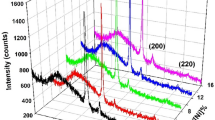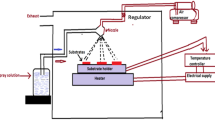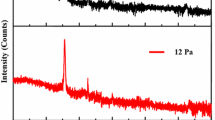Abstract
Zinc oxide (ZnO) and Cu-doped ZnO (CZO) thin films were prepared on borosilicate glass substrates by spray pyrolysis technique. The X-ray diffraction study revealed that Cu doping caused a reduction in crystallite size. AFM study showed an increase in roughness with doping. This is attributed to the aggregation of particles to form clusters. From transmission electron microscopy analysis, the particle size is measured to be in the range 30–65 nm (average particle size 48 nm) for undoped ZnO, whereas it is in the range 24–56 nm (average particle size 40 nm) for CZO film. The electrical resistivity of the thin films was investigated in the presence of air as well as N2 mixed air at different temperatures in the range 30–270 °C. The change in resistivity properties was explained on the basis of conduction phenomena within the grain along with the grain boundaries as well as Cu- and N2-induced defect states. The thermal activation energy of ZnO was found to be in the range 0.04–0.7 eV and dependent on Cu doping and N2 level in air.









Similar content being viewed by others
References
Iwata K, Sakemi T, Yamada A, Fons P, Awai K, Yamamoto T, Shirakata S, Matsubara K, Tampo H, Sakurai K, Ishizuka S, Niki S (2005) Improvement of ZnO TCO film growth for photovoltaic devices by reactive plasma deposition (RPD). Thin Solid Films 480–481:199–203
Znaidi L, Soler Illia GJA, Benyahia S, Sanchez C, Kanaev AV (2003) Oriented ZnO thin films synthesis by sol–gel process for laser application. Thin Solid Films 428:257–262
Ohta H, Hosono H (2004) New direction in nanotube science. Mater Today 7:42–51
Pearton SJ, Norton DP, Ip K, Heo YW, Steiner T (2005) Recent progress in processing and properties of ZnO. Prog Mater Sci 50:293–340
Kim GH, Kim DL, Ahn BD, Lee SY, Kim HJ (2009) Investigation on doping behavior of copper in ZnO thin film. J Microelectron 40:272–275
Neumark GF (1989) Achievement of well conducting wide band-gap semiconductors: role of solubility and of nonequilibrium impurity incorporation. Phys Rev Lett 62:1800–1803
Minami T, Sato H, Nanto H, Tanaet S (1985) Group III impurity doped zinc oxide thin films prepared by RF magnetron sputtering. Jpn J Appl Phys 24:L781–L784
Zhang SB, Wei S-H, Zunger A (1998) A phenomenological model for systematization and prediction of doping limits in II–VI and I–III–VI2 compounds. J Appl Phys 83:3192–3196
Chadi DJ (1994) Doping in ZnSe, ZnTe, MgSe, and MgTe wide-band-gap semiconductors. Phys Rev Lett 72:534–537
Zhang SB, Wei SH, Zunger A (2000) Microscopic origin of the phenomenological equilibrium “Doping Limit Rule” in n-type III–V Semiconductors. Phys Rev Lett 84:1232–1235
Hu J, Gordon RG (1991) Textured fluorine-doped ZnO films by atmospheric pressure chemical vapor deposition and their use in amorphous silicon solar cells. Sol Cells 30:437–450
Bellini JV, Morelli MR, Kiminami RA (2002) Electrical properties of polycrystalline ZnO:Cu obtained from freeze-dried ZnO+copper(II) acetate powders. J Mater Sci Mater Electr 13:485–489
Mukae K, Tsuda K, Nagasawa I (1977) Non-ohmic properties of ZnO-rare earth metal oxide-Co3O4 ceramics. Jpn J Appl Phys 16:1361–1368
Hoon HH, Ling CP (2002) Effects of MnO2 doping in V2O5-doped ZnO varistor system. Mater Chem Phys 9347:1–6
Han J, Mantas PQ, Senos AMR (2001) Effect of Al and Mn doping on the electrical conductivity of ZnO. J Eur Ceram Soc 21:1883–1886
Han J, Senos AMR, Mantas PQ (2002) Deep donors in polycrystalline Mn-doped ZnO. Mater Chem Phys 75:117–120
Fons P, Nakahara K, Yamada A, Iwata K, Matsubara K, Takasu H, Niki S (2002) A XANES study of Cu valency in Cu-doped epitaxial ZnO. Phys Stat Sol (b) 229:849–852
Oztas M, Bedir M (2008) Thickness dependence of structural, electrical and optical properties of sprayed ZnO:Cu films. Thin Solid Films 516:1703–1709
Behera D, Acharya BS (2010) Study of microstructural and photoluminescence properties of Li-doped ZnO thin films prepared by spray pyrolysis. Ionics 16:543–548
Behera D, Acharya BS (2008) Nanostar formation in Al-doped ZnO thin film deposited by dip-dry method and its characterization using atomic force microscopy, electron probe microscopy, photoluminescence and laser raman spectroscopy. J Luminescence 128:1577–1586
Minegishi K, Koiwai Y, Kikuchi Y, Yano K, Kasuga M, Shimizu A (1997) Growth of p-type zinc oxide films by chemical vapor deposition. Jpn J Appl Phys 36:L1453–L1455
Guo XL, Tabata H, Kawai T (2001) Pulsed laser reactive deposition of p-type ZnO film enhanced by an electron cyclotron resonance source. J Cryst Growth 223:135–139
Joseph M, Tabata H, Saeki H, Ueda K, Kawai T (2001) Fabrication of the low-resistive p-type ZnO by codoping method. Phys B 302–303:140–148
Tabata H, Saeki H, Guo SL, Choi JH, Kawai T (2001) Control of the electric and magnetic properties of ZnO films. Phys B 308–310:993–998
Wang ZL (2004) Zinc oxide nanostructures: growth, properties and applications. J Phys Condensed Matter 16:R829–R858
Lee J, Gao W, Li Z, Hodgson M, Metson J, Gong H, Pal U (2005) Sputtered deposited nanocrystalline ZnO films: a correlation between electrical, optical and microstructural properties. Appl Phys A Mater Sci Process 80:1641–1646
Zhou Z, Kato K, Komaki T, Yoshino M, Yukawa H, Morinaga M, Morita K (2003) Electrical conductivity of Cu-doped ZnO and its change with hydrogen implantation. J Electroceram 11:73–79
Goh EG, Gong H (2002) Crystal growth of Al-doped ZnO films under different sputtering conditions. Int J Mod Phys B 16:287–293
Sato Y, Sato S (1996) Preparation and some properties of nitrogen-mixed ZnO thin films. Thin Solid Films 281–282:445–448
Lee EC, Kim YS, Jin YG, Chang KJ (2001) First-principles study of the compensation mechanism in N-doped ZnO. Phys B 308–310:912–915
Cheong B-H, Park CH, Chang KJ (1995) First-principles study of the compensation mechanism for nitrogen acceptors in ZnSe. Phys Rev B 51:10610–10614
Takata M, Tsubone D, Yanagida H (1976) Dependence of electrical conductivity of ZnO on degree of sintering. J Am Ceram Soc 59:4–8
Morrison SR (1987) Mechanism of semiconductor gas sensor operation. Sens Actuators 11:283–287
Yu JH, Choi GM (2002) Selective CO gas detection of Zn2SnO4 gas sensor. J Electroceram 8:249–255
Chen HY, Lau SP, Chen L, Lin J, Huan CHA, Tan KL, Pan JS (1999) Synergism between Cu and Zn sites in Cu/Zn catalysts for methanol synthesis. Appl Surf Sci 152:193–199
Caglar Y, Zor M, Caglar M, Ilican S (2006) Influence of the indium incorporation on the structural and electrical properties of zinc oxide films. J Optoelectr Adv Mater 8:1867–1873
Acknowledgments
The authors thank the Director, IMMT, Bhubaneswar for his kind permission to publish this work. The authors also thank Mr. Debadutta Sahu for his help in recording the SEM images.
Author information
Authors and Affiliations
Corresponding author
Rights and permissions
About this article
Cite this article
Behera, D., Panigrahi, J. & Acharya, B.S. Probing the effect of nitrogen gas on electrical conduction phenomena of ZnO and Cu-doped ZnO thin films prepared by spray pyrolysis. Ionics 17, 741–749 (2011). https://doi.org/10.1007/s11581-011-0564-0
Received:
Revised:
Accepted:
Published:
Issue Date:
DOI: https://doi.org/10.1007/s11581-011-0564-0




